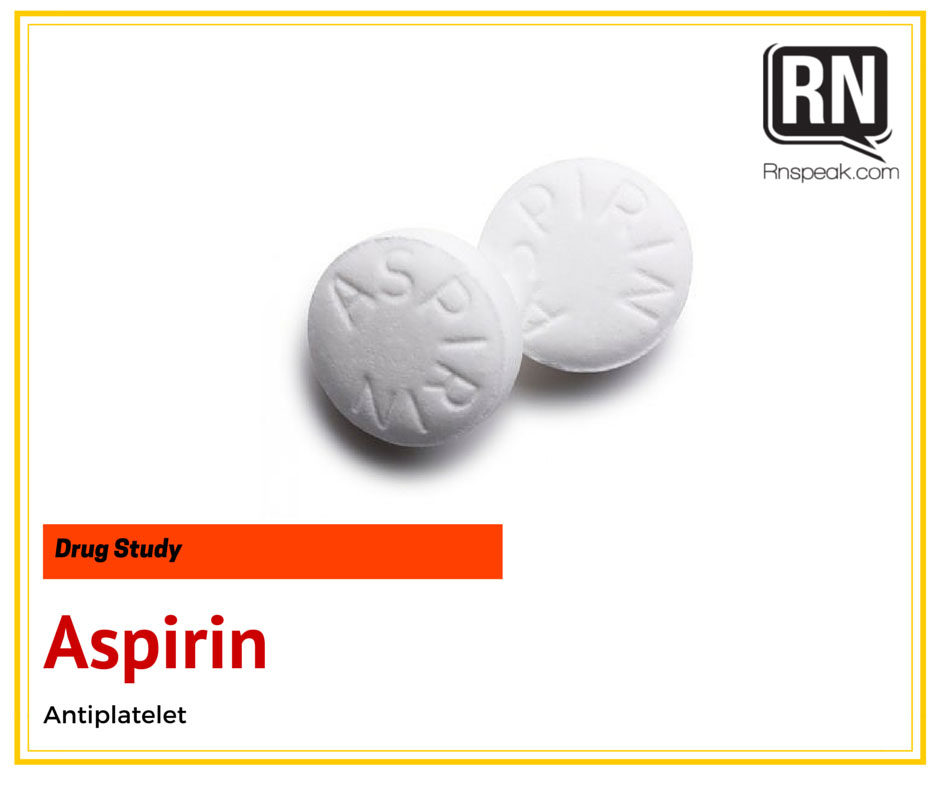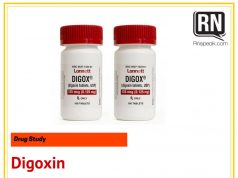Generic name: Aspirin
Brand name: Aspergum, Bayer, Easprin, Ecotrin, Empirin, Genprin, Halfprin, Norwich
Pregnancy Category: D
Drug Classes: Analgesic, Anti-inflammatory, Antiplatelet, Antipyretic, Antirheumatic, NSAID, Salicylate
Therapeutic actions:
- Analgesic and antirheumatic- inhibits prostaglandin (an inflammatory mediator) synthesis
- Antipyretic effect – this action is not fully understood but drug study of aspirin is correlated with the ability of the drug to act in the thermoregulatory center of the hypothalamus by blocking the endogenous pyrogen through inhibiting synthesis of prostaglandin intermediary.
- Antiplatelet – aspirin drug study reveals the ability of the drug to inhibit thromboxame A2 (a potent vasoconstrictor and inducer of platelet aggregation) synthesis
Indications:
- Mild to moderate pain
- Fever
- Inflammatory conditions such as rheumatic fever, arthritis, and spondyloarthropaties
- Reduction of risk of recurrent transient ischemic attack (precursor to stroke) or cardiovascular accident (stroke) in patients with history of TIA due to fibrin platelet emboli or ischemic stroke
- Unlabeled use: prophylaxis against cataract formation with long-term use
Contraindications and cautions:
- People with allergy to salicylates or NSAIDs. This is more common to people with nasal polyps, asthma, and chronic urticaria.
- People with haemophilia, allergy to tartrazine (cross-sensitivity is common), bleeding ulcers, blood coagulation defects, and with Vitamin K deficiency (increased risk of bleeding)
- Caution with people who have impaired renal function, children and teenagers (risk for developing Reye’s Syndrom), patients who will have surgery within 1 week, and pregnant women (it readily crosses placenta and is a possible teratogen) as well as lactating mothers.
Available forms:
- tablets – 81, 165, 325, 500, 650, 975 mg
- Sustained release tablets – 650, 800 mg
- Gum tablets – 227.5 mg
- Suppositories – 120, 200, 300, 600 mg
Dosages:
(Adults)
- Ischemic stroke and TIA: 51-325 mg/day
- Angina or recurrent myocardial infarction (MI): 75-325 mg/day
- Suspected MI: 160-325 g as soon as possible; continue for 30 days
- All forms of arthritis: 3g/ day in divided doses
- Acute rheumatic fever: 5-8g/day
(Pediatric patients)
- Analgesic and antipyretic: 10-15 mg/kg/dose every 4 hours, up to 60-80 mg/kg/day
Note: Do not give to patients with chickenpox and influenza symptoms as well as febrile children with signs and symptoms of dehydration (e.g. increased thirst, irritability, dry skin and mucous membranes, etc).
Pharmacokinetics:
- Oral route: onset – 5-30 minutes; peak – 15-120 minutes; duration – 3-6 hours
- Rectal route: onset – 1-2 hrs; peak – 4-5 hrs; duration – 6-8 hours
Metabolism: Hepatic
Half-life: 15 minutes-12 hours
Distribution: Crosses placenta, enters breastmilk
Excretion: Urine
Side Effects and Adverse Reactions:
- Acute aspirin toxicity – respiratory alkalosis, hemorrhage, tachypnea, confusion, asterixis, pulmonary edema, seizures, tetany, metabolic acidosis, renal and respiratory failure
- Aspirin intolerance – exacerbation of bronchospasm, rhinitis
- Gastrointestinal: nausea, dyspepsia, heartburn, epigastric discomfort, anorexia, hepatotoxicity
- Hematologic: occult blood loss, hemostatic defects
- Hypersensitivity: anaphylactoid reactions to anaphylactic shock
- Salicylism: dizziness, tinnitus, difficulty hearing, nausea, vomiting, diarrhea, mental confusion
Nursing Responsibilities:
- Check and verify with doctor’s order and Kardex.
- Observe rights in medication administration such as giving the right drug to the right patient using the right route and at the right time.
- Assess skin color and presence of lesions as this may indicate hepatotoxicity, allergy, bleeding, and other complications.
- Assess patient’s orientation to time and place as the drug may cause dizziness and confusion.
- Give drug with food or after meal if GI upset occurs.
- To reduce the risk of the tablet lodging in the esophagus, give drug with full glass of water.
- Ensure that patient does not crush and chew tablets as well as sustained release preparations to prevent losing drug’s effectivity.
- If aspirin has vinegar-like odor, do not use and dispose.
- In case of overdose, institute emergency procedures and prepare equipments for gastric lavage, induction of emesis, and activated charcoal.
- Continue monitoring clotting factors, bleeding time, liver and renal function tests for long-term drug therapy.
- Observe patient for signs and symptoms of bleeding such as easy bruising, bleeding in the gums, and nosebleeds.
- Monitor vital signs.
- Raise side rails up to ensure patient’s safety.
- Monitor for signs and symptoms of drug allergy such as difficulty of breathing, pruritus, and rashes.
- Provide a room environment conducive for resting.
Client and Family Teaching:
- Instruct to keep drugs from children.
- Instruct to avoid OTC drugs as many of those contain aspirin so serious overdose can occur.
- Encourage client to ask for assistance when performing activities of daily living such as bathing because this drug can cause dizziness and confusion.
- In case of nausea and vomiting, instruct client to eat crackers and have carbonated drink before rising in the morning.
- Emphasize with the client to avoid or limit intake of highly-seasoned and oily food such as bacon and canned goods as these can increase the risk of developing heartburn and nauseous feeling.
- Instruct client to use soft-bristled toothbrush and electric razor to prevent bleeding.
- Inform client that he or she will experience these common side effects: epigastric discomfort, nausea, difficulty hearing, tinnitus or ringing in the ears, vomiting, and dizziness.
- Instruct client to report bloody stools, rapid or difficult breathing, and confusion.
- Encourage client to increase oral fluid intake to facilitate excretion of drug.
- Instruct client to swallow drug whole and to take it with food to prevent GI upset and promote drug effectivity.
Reference: 2011 Lippincott’s Nursing Drug Guide








